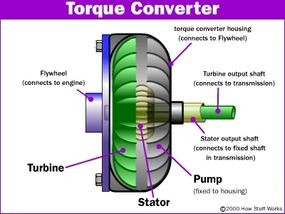The torque converter is a vital component in most automatic transmissions, acting as a fluid coupling that allows the engine to spin independently of the transmission at a standstill, while also multiplying torque when needed for acceleration. Housed within a robust casing, the torque converter is comprised of four key elements that work in harmony to ensure smooth and efficient power transfer. These components are the impeller, turbine, stator, and transmission fluid, each playing a critical role in the overall function of the automatic transmission system.
The torque converter is directly connected to the engine’s flywheel, causing it to rotate at the same speed as the engine. The impeller, which functions as a pump, is internally connected to this housing. As the engine spins, so does the impeller, initiating the process of fluid movement within the torque converter. The internal arrangement of these parts is crucial for its operation, as illustrated in the cutaway view below.
The Impeller: A Centrifugal Pump
At the heart of the torque converter’s operation is the impeller. This component operates as a centrifugal pump. As the impeller rotates, driven by the engine, it forces transmission fluid outwards due to centrifugal force. This action is similar to how a washing machine’s spin cycle pushes water away from the center of the drum. As the fluid is expelled outwards, a vacuum is created at the center of the impeller, drawing more fluid in to maintain a continuous flow.
Turbine: Receiving Fluid Power
The fluid, propelled by the impeller, then enters the turbine. The turbine is connected to the transmission input shaft. As the fluid strikes the curved blades of the turbine, it imparts its energy, causing the turbine to rotate. This rotation is then transferred to the transmission, initiating the movement of the vehicle through the driveshaft, differentials, and ultimately to the wheels. The curved design of the turbine blades is essential, as it forces the fluid to change direction as it passes through. This change in direction is key to transferring momentum from the fluid to the turbine.
This principle of directional change is fundamental to the torque converter’s function. To alter the direction of any moving object, a force must be applied. In this case, the impeller applies force to the fluid, and in reaction, the fluid applies force back onto the turbine blades, causing it to spin. This interaction is the essence of how power is transferred within the torque converter.
Stator: Enhancing Torque Multiplication
As the fluid exits the turbine at its center, it is moving in a direction opposite to the rotation of the impeller and engine. If this fluid were to directly impinge upon the impeller, it would impede the engine’s rotation, leading to power loss and inefficiency. This is where the stator comes into play. The stator is strategically positioned between the turbine and impeller to redirect the fluid flow. By changing the direction of the fluid returning from the turbine before it reaches the impeller again, the stator effectively multiplies the torque, enhancing the performance of the transmission, especially during acceleration. The stator is a crucial element in maximizing the efficiency and power delivery of the torque converter system.
Further exploration of the stator and its precise function will provide a deeper understanding of torque converter operation and its significance in automotive technology.

